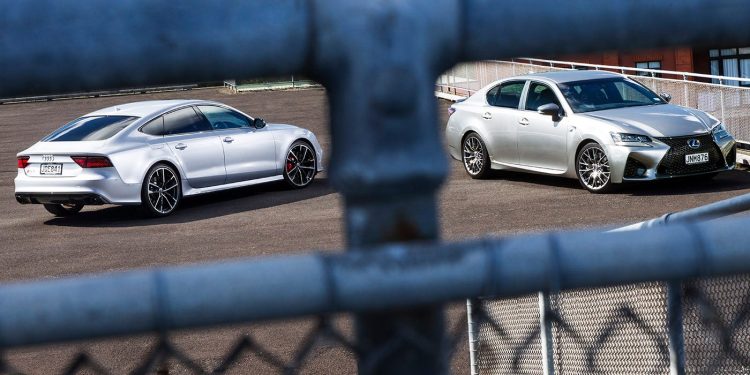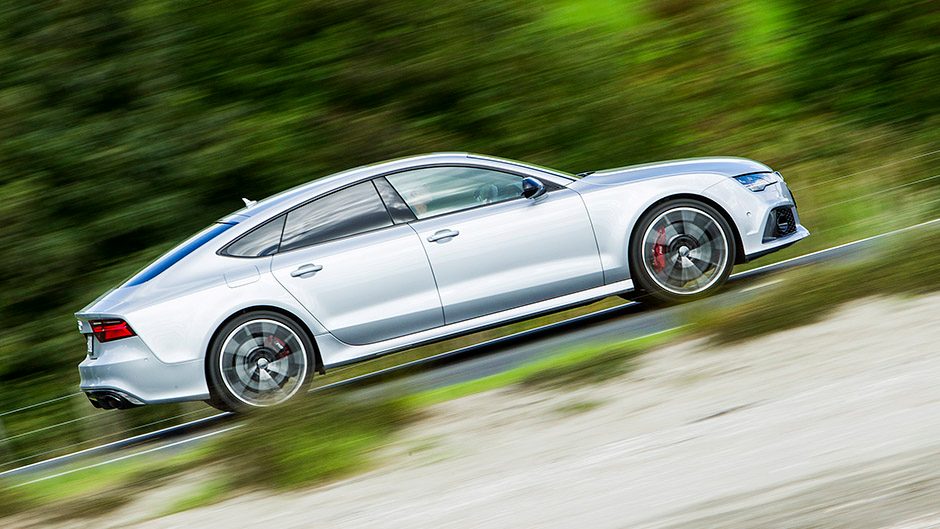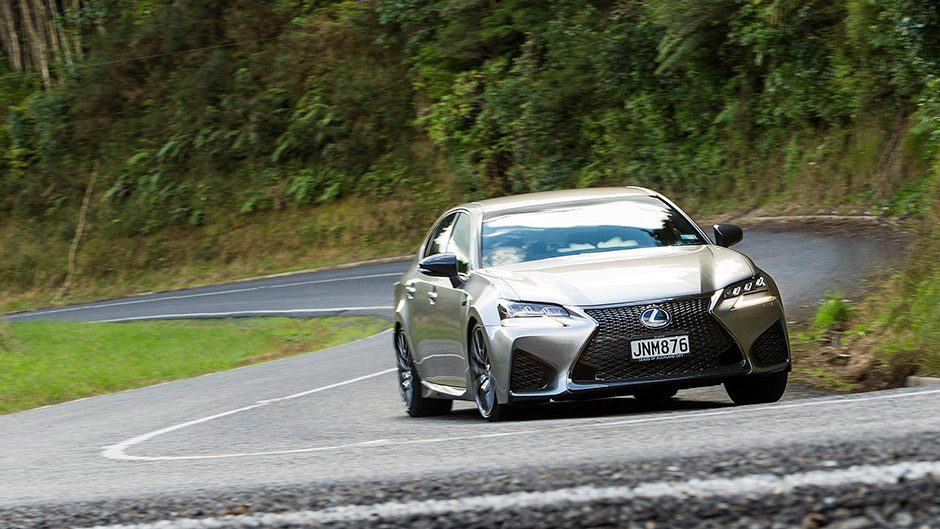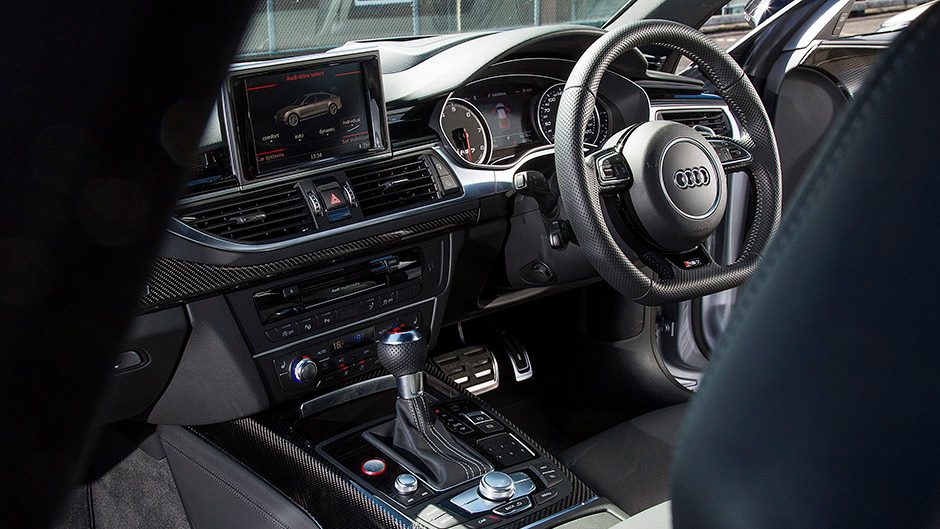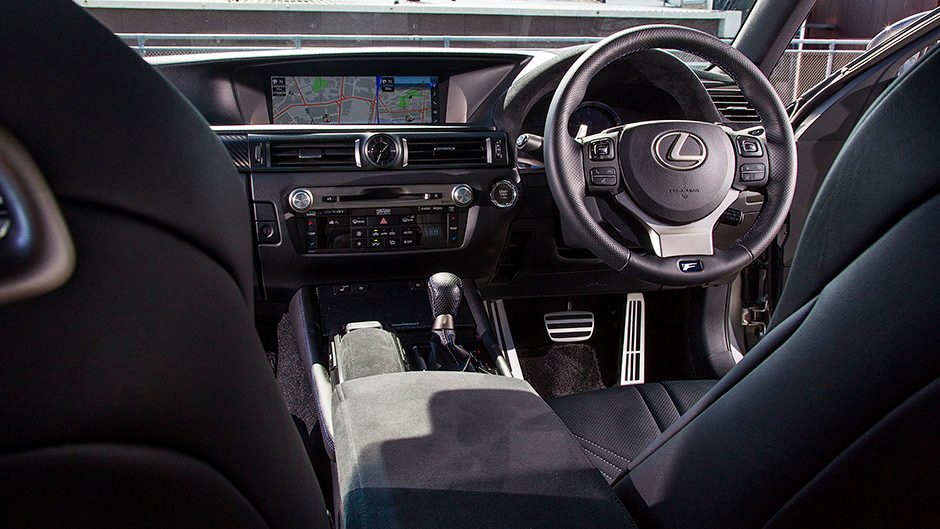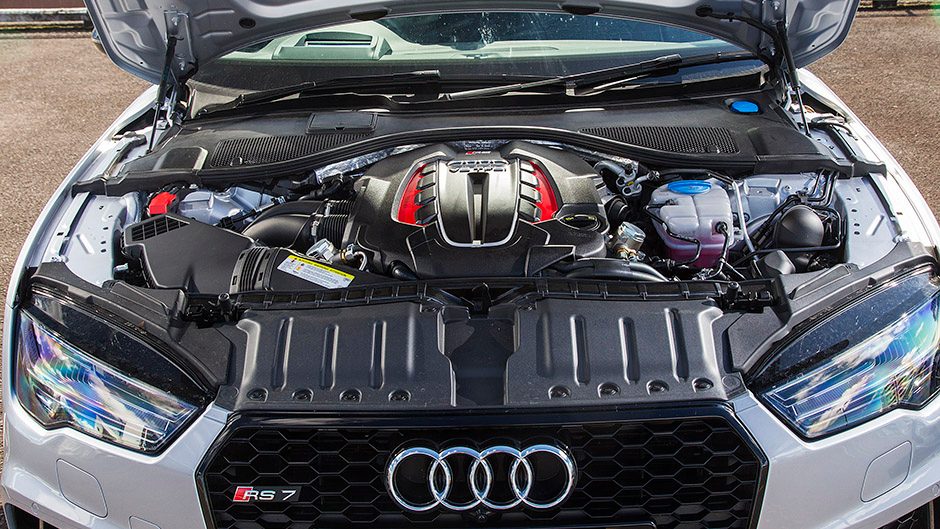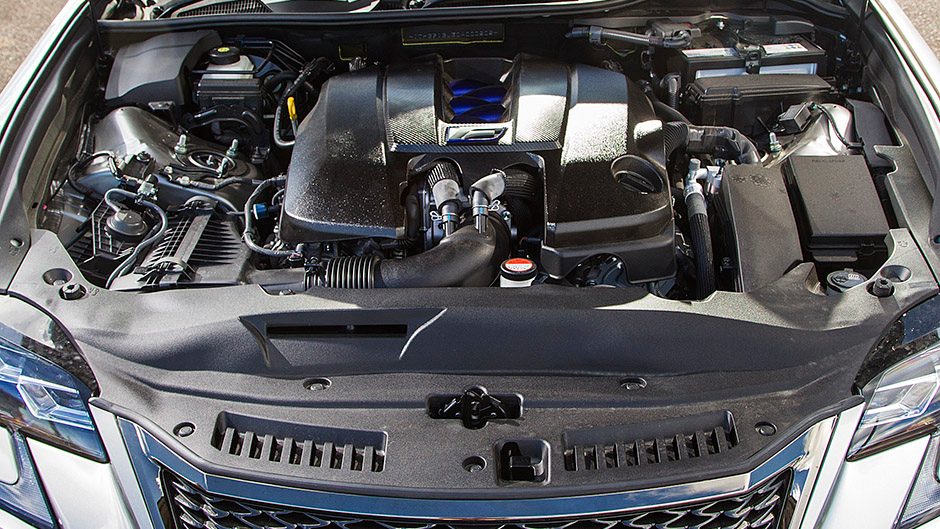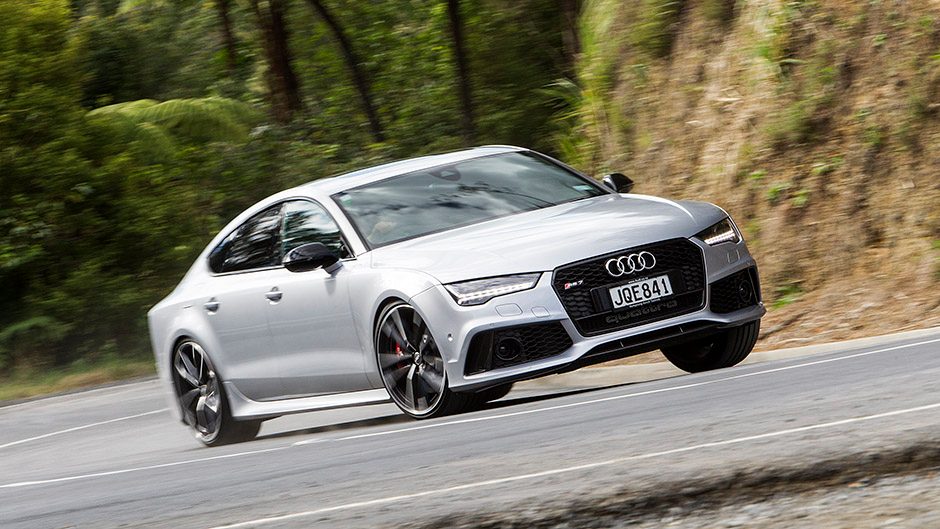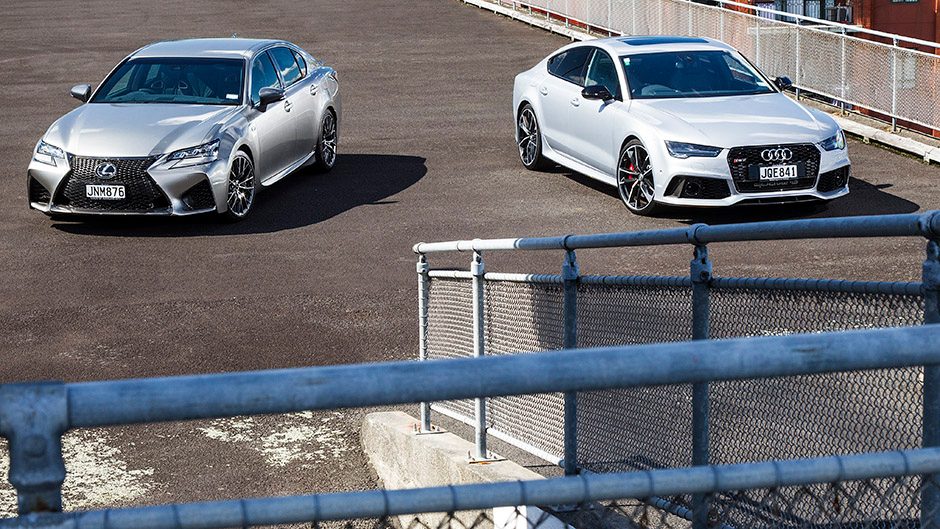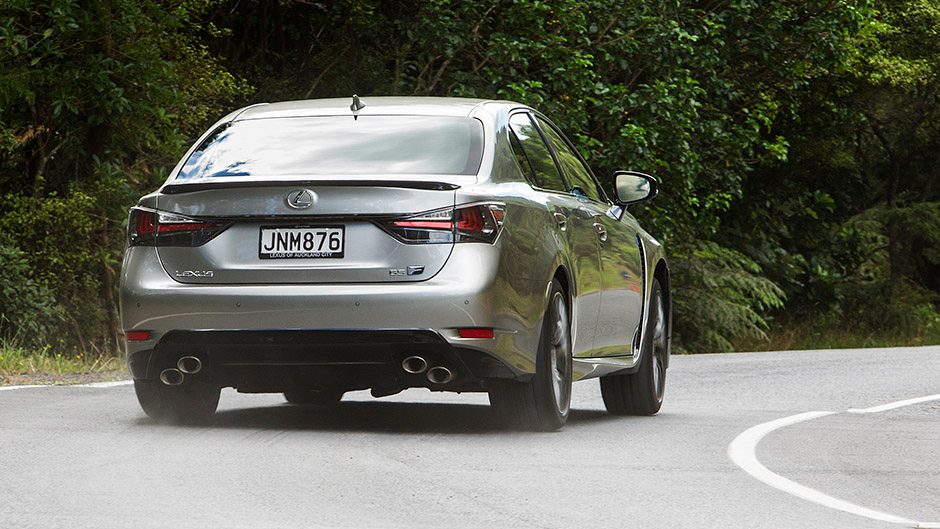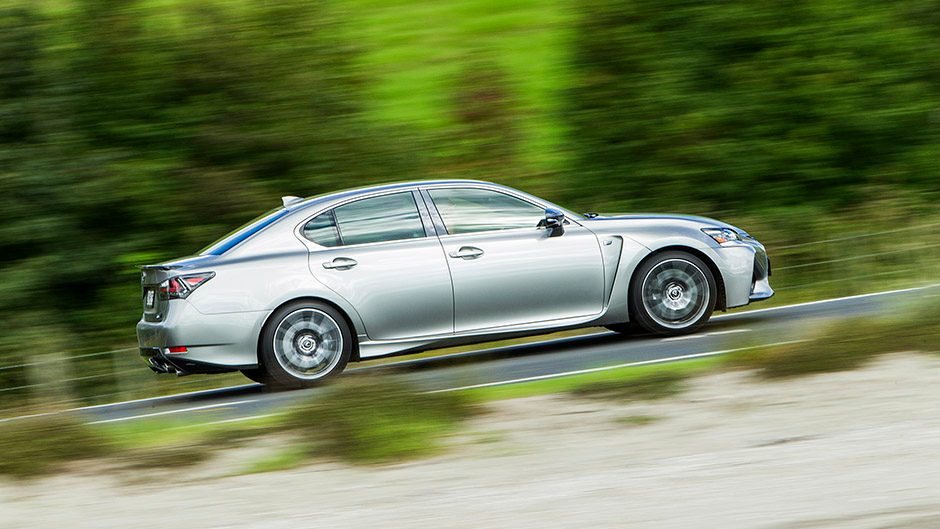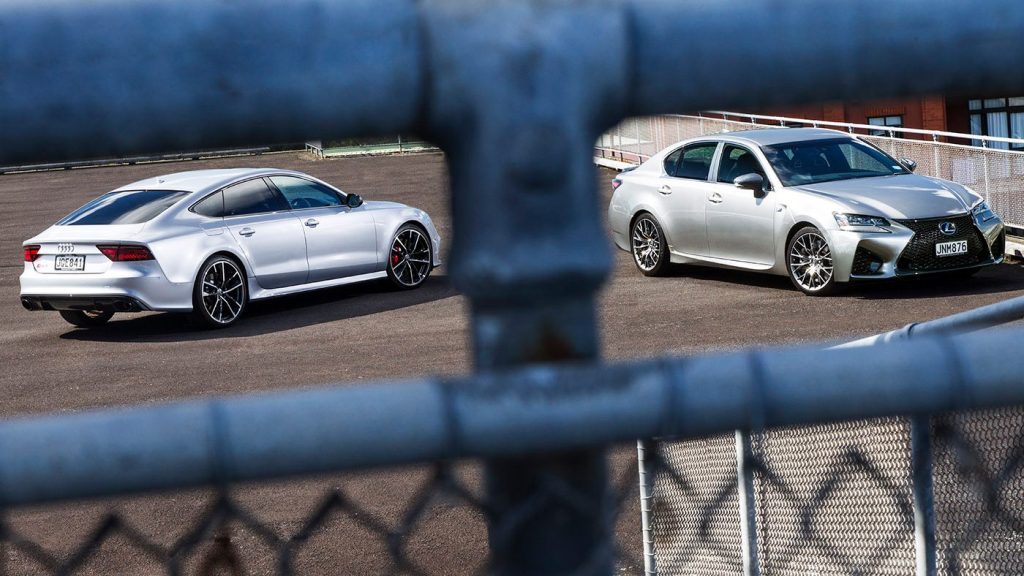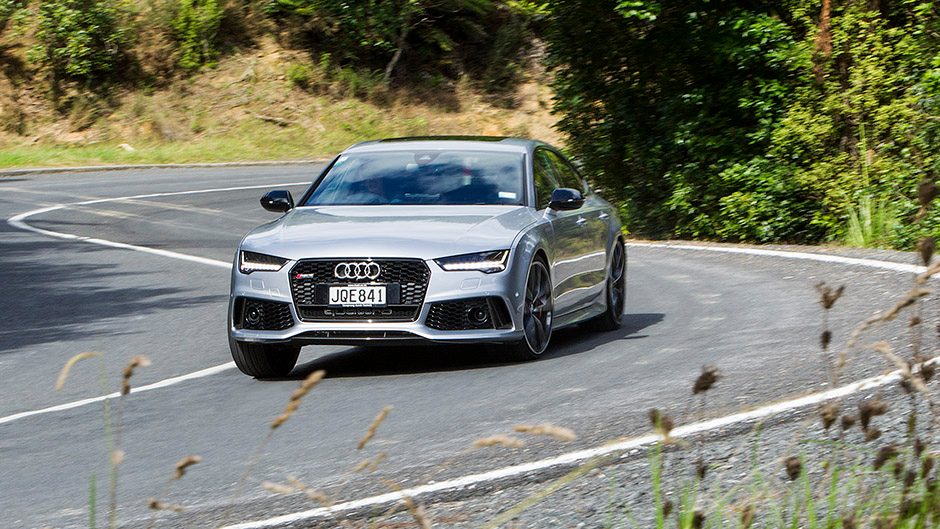2016 Audi RS 7 vs Lexus GS F comparison
Words: Peter Louisson | Photos: Tom Gasnier
Hereto we compare a couple of v8 luxo offerings with eight-speed autos and sports pretensions. But they otherwise couldn’t be more different.
Occasionally we pick up a pair of cars on the same day that you think will make for a good comparison. The two vehicles set out before you are about the same size, and being both from the luxury sport segment would seem worthy of a face-off. And yet, they’re poles apart, aside from sharing V8 status, eight-speed autos, and bach-like sticker prices. For one has two turbos, one none. Where one is a four-door five-seater, the other is a five-door four-seater. One is rear drive and quite sporty, the other four-wheel drive and, despite the Performance tag, decidedly comfortable on the go.
The bigger car is European and costs nearly $230k, the other Japanese and $175k. Finally, one is rapid, while the other is nearly supercar quick. Therefore, from the outset know that we can’t really recommend one over the other as they will surely appeal to different buyer types. Both have their moments, big time. By paying more you very definitely get more, which is not unexpected, and by paying less you get a compromise. The two vehicles we’re referring to are both new in one sense, not in another. They’re both an addition to a line-up that’s been around for some time.
In the case of the Lexus GS F, take the 5.0L naturally aspirated engine and eight-speed auto from the RC F and insert it into a stiffened GS chassis, with the usual L-finesse styling cues and you essentially have a new F model. From Europe, Audi presents a titivated version of its RS 7 dubbed RS 7 Performance. Sporting a biturbo 4.0L V8 with fettling to the exhaust and other tweaks, it manages much the same power output as the R8, just under 450kW, and an overboosted 750Nm from 2500rpm.
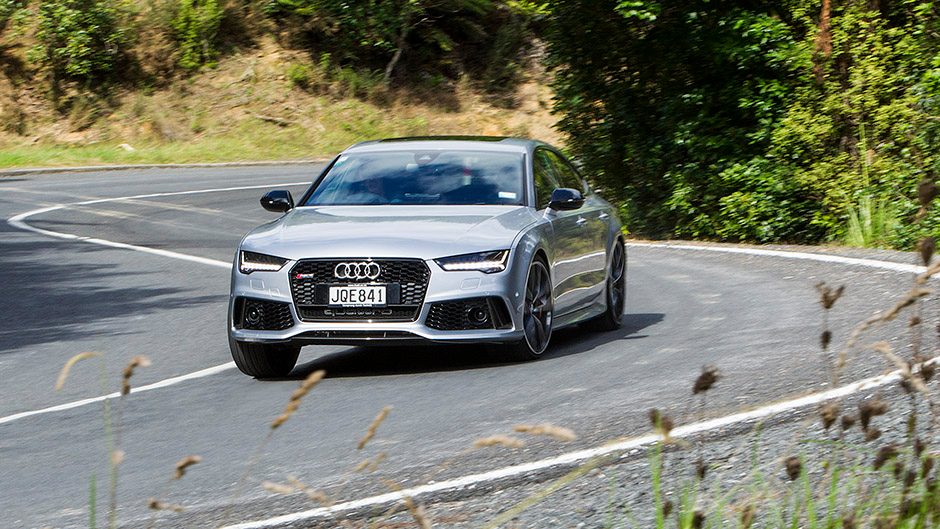
By contrast, the output of the atmo GS F is a mere 530Nm and that’s not to hand until 4800rpm. Power output of 351kW arrives at a high 7100rpm while the Audi’s chimes in 1000rpm earlier. However, the GS F looks slightly smaller physically and is indeed more compact. The Audi is larger, but lower riding with its coupe-style roofline, despite sporting much larger 21-inch alloys to the GS F’s weedy-looking 19s. On appearances, the GS F looks rather like a GS with radical new front and rear ends grafted on. The air intakes are racy, as is the diffuser but basically this is an enhanced luxo sedan, with its attendant drawback, viz, a mean entrance to the 520L luggage space whereas the Audi with its liftback format and full split folding makes a more versatile high performance machine.
On that, there is a vast gulf separating these two for straight line speed. You don’t append a “Performance” tag to something for no reason, and the hottest RS 7 is surprisingly rapid transit. The like-powered RS 6 posted a best 0-100 time of 3.65sec and that’s essentially what Audi claims for the RS 7 Performance (down from 3.9 for the base RS 7 to 3.7sec). It’s what you’d call a particularly easy car to performance test. Push the Dynamic setting, set ESP to intermediate, load ‘er up on the brake with the engine at 4500rpm and let rip.
With the turbos already spooled this explodes away from the start line, the very first run posting a 3.73sec time. The next run produced an even better launch, stopping the clocks at 3.41sec, and finally it logged best of 3.3sec. Not bad for a 4.0L V8 pushing a vehicle weighing 2030kg, especially when you consider the 400kg lighter R8 managed a time just 0.2sec quicker. We cannot think of anything based on a luxury car that even runs this close in a straight line, except for the S8.
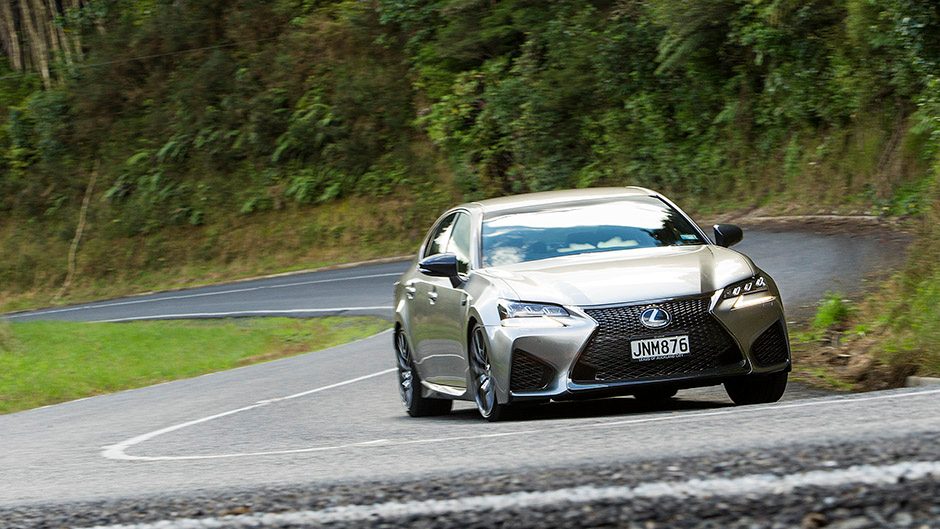
The RS 7 P also came itchingly close to supercar territory for its overtaking time, a scant 2.08sec. It’s are-you-kidding-me quick, and is right up there with racy things like the M6, only it can tote four people in comfort. So was the Lexus a disappointment by comparison? To a degree, because it overshot its claim by as much as the Audi slayed it. Quoted to run 4.6sec, we only recorded one run under 5.0sec (4.95sec), and we tried all the known tricks.
The Lexus lacks a launch control function so on the brake the engine is turning only 2500rpm when stopped. Given peak output is thousands of revs higher, the GS F launch is way too lazy, and a half second is wasted getting into some kind of zone where the V8 feels happy. However, it’s less than a second slower than the Audi on the overtake, and on road in the zone it feels the opposite of slovenly.
There is an enormous difference driving this pair, in a motive sense. Out of the graunch and grind of city traffic, if the rev counter isn’t showing at least 3500rpm, there’s nothing much happening on either the speed or sonics front but the Lexus really does seem to come alive from there on, and it makes rather an appealing V8 bark doing so. Even more would be even better, but a whole lot more from the Audi exhaust would be a whole lot better as well. At least the RS 7 makes a bit of a sonic splash at start up, and some exciting exhaust explosions on the overrun, whereas the GS F sounds better accelerating. That said, the autoblips on the downchange in its Sports modes are pretty cool. Driven on its own, you’d rate the Lexus as rather quick when in its correct operating area, and the more revs the faster the thing hikes.
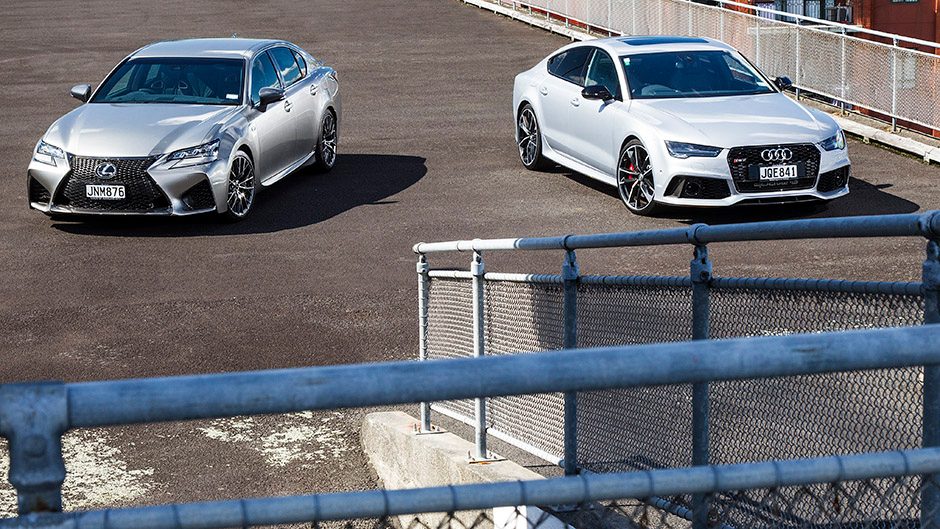
Up against the RS 7, however, and pretty much everything seems sluggish; this has so much power down low, its overboosted 750Nm on tap from 2500rpm. With that staccato-shifting eight-speed ZF as a companion, a headlong rush is just milliseconds away, any gear, any time. Conventional auto boxes have come a long way in recent times and the eight-speeder in the Lexus is also rapid fire, though not quite as buttery as the Audi on full-throttle shifts. But then nothing about the Lexus is what you’d describe as creamy or smooth, especially the ride. When you sign up for an F car, you know that Lexus is favouring handling over ride and it makes no bones about that. If you want waft, you look to the other GS models in the range. And that’s perhaps an even bigger difference for this pair than the performance aspect.
The Audi uses adaptive dampers whereas the GS F has fixed suspension settings. Even in the very top dynamic setting, the Audi clearly displays more body roll and pitch than the Lexus, not that it’s necessarily apparent from behind the wheel, but it certainly is in the images. The downside for the GS F is a busier ride at slower speeds, though on lumpy tracks at open-road pace, the ride is more acceptable. But if you’re after luxo butt pampering, look elsewhere. And while the Lexus is ostensibly a five-seater, no-one apart from a child would think the middle seat was in any way useable or luxurious. Audi just doesn’t even bother on that count, the middle seat being part of the rear centre console. We far prefer the cushioning sports seats of the Audi to the Lexus which, like the underpinnings, are a touch too firm and sporty.
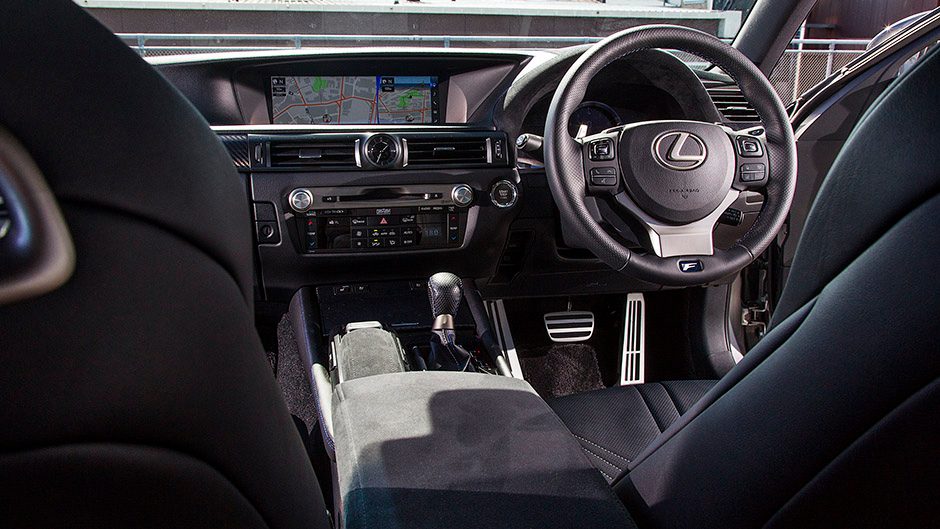
It has squab ventilation though, where the Audi doesn’t. Each of these has torque apportioning rear diffs, and in the top Sport+ mode, when you push the ESC button the Lexus relaxes (but won’t turn off altogether) the point at which the system intervenes. That allows a bit of tail wagging under power, but get too enthusiastic and the fun soon ceases. It’s similar for the Audi, only with 4wd the fronts always get in on the business so there’s never any real drift action going on. Perhaps it would be different in the wet but then why would you? Both cars have electromechanical power steering and they display some of the better steering characteristics of the breed.
With a more even weight split front to rear the Lexus turns keener than the Audi, as you’d expect, and being lighter and rear drive it isn’t so hard on its rubber either. The RS 7 had spent some time on track and a couple of its tyres were looking decidedly second-hand. Guess you get that with heavy-handed (lead-footed) motoring scribes. Both cars had done around 4000km and the lighter car had far few signs of tyre wear. Bottom line? Performance favours the Audi, dynamics the Lexus, but you’d have to say the pair does a reasonable job at both. These two differ little on the specification front, the Audi adding, as mentioned, adaptive damping, and it also gets a sunroof and bigger alloys. Those on the Lexus look good, if a shade small, so long as you can employ someone else to clean them.
Both cars feature mouse-driven computer like devices for secondary functions, the Lexus example being frustrating in use, even when optimised. Not that MMI is a whole lot better, but then none of these is exactly great. Let’s not get us started. Both have powered access to the luggage bay, a bit of a waste (especially the added weight) on a sedan. Each comes with comfort entry and push button start, and masses of airbags (10 in the case of the Lexus).
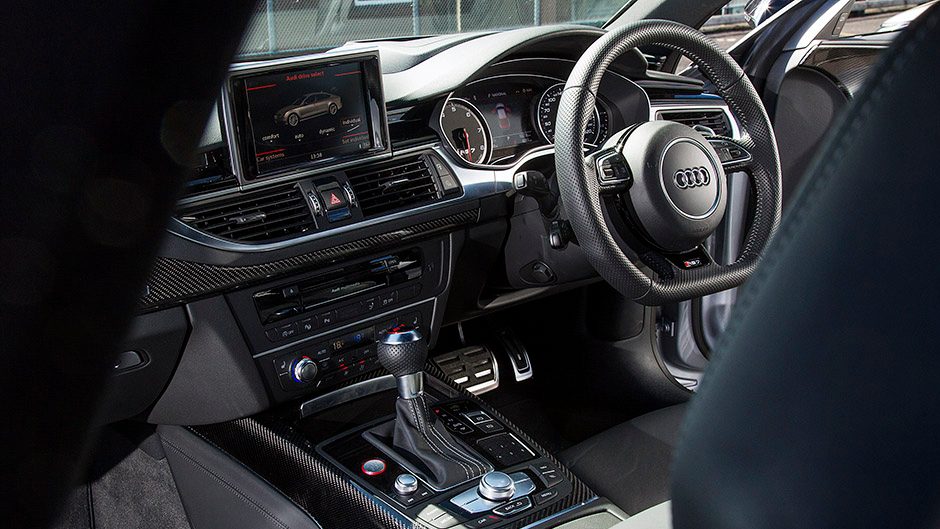
Bottom line? If you want something luxuriously oriented with novel coupe styling that’s bat-out-of-hell quick the RS 7 Performance shouldn’t disappoint. The GS F is more the conventional modern luxo sedan offering, only with added sports starch. It delivers a more traditional sports feeling, and requires more of its driver to give of its best. While not as quick as the Audi, rest assured, it does the job, and you don’t pay quite as much.
| Model | Audi RS 7 Performance Sportback | Price | $224,900 |
| Engine | 3993cc, V8, 445kW/750Nm | Drivetrain | 8-speed auto, all-wheel drive |
| Fuel Use | 9.5L/100km | C02 Output | 262g/km |
| 0-100km/h | 3.30sec | Weight | 1867kg |
| Model | Lexus GS F | Price | $174,900 |
| Engine | 4969cc, V8, 351kW/530Nm | Drivetrain | 8-speed auto, rear-wheel drive |
| Fuel Use | 11.3L/100km | C02 Output | 221g/km |
| 0-100km/h | 4.95sec | Weight | 2030kg |


